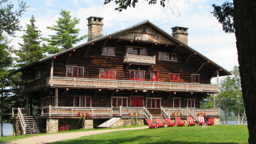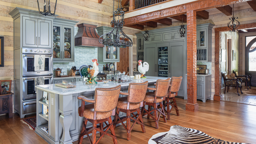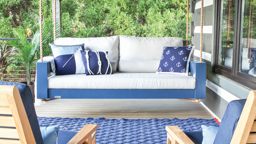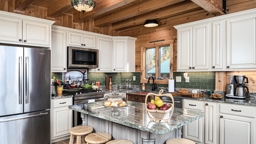
For many current and aspiring log and timber homeowners, there’s no place better than a retreat along the shore. Whether it’s a lake, river or pond, few experiences can compete with a crisp morning — mist rising from the water’s surface as it reflects the vibrant colors of the surrounding nature.
Having a dock is an integral part of the joy of waterfront living, whether your goal is to tie up a boat, set up the perfect fishing spot or simply create a space to watch the sun as it sinks beyond the horizon. But before you head down to the shore with hammer and board in hand, there are a few things you should know, including the fact that you have choices.
Types of Docks
There is more than one way to design and build a dock, and once you start to investigate the options, it can be a bit overwhelming.
To figure out which dock style is right for your waterfront location, start by thinking of them in two main categories, non-permanent (removable or adjustable) and permanent. Non-permanent docks, like floating docks, move with the water. Permanent, or “fixed,” docks have a set height and are situated above the waterline on a foundation, usually constructed of concrete, steel or wood.
Several key factors will determine which of these is right for your property:
-
Water type
-
Local regulations
-
Water depth
-
Your intended use: boat access, fishing, swimming, entertaining
-
Size and number of watercraft
-
Shoreline profile
-
Water fluctuation amounts
-
Waves and currents
-
Soil composition
Non-Permanent Docks
If your waterline fluctuates in height over the course of the year, but the water is deep, or if permanent posts are not compatible with the ground due to soil softness or water depth, a non-permanent dock may be the best decision for your property. These come in a few different styles, but floating models are the most common. These are large platforms that float on the water’s surface and are tethered to the shore.
Veronica Williams, director of marketing at Pond King Inc. in Gainesville, Texas, explains part of that popularity is thanks to the fact floating docks can adjust for whatever Mother Nature throws at them.
“They are quite effective in accommodating water elevation fluctuations due to drought, evaporation, or best case, rain!” she says. “Because of our unique hinge system ... our standard steel-framed and deluxe steel-framed docks can accommodate water elevation changes up to 10 feet.” That’s no small feat.
Floating docks also make great platforms for fishing and boating, as it situates you right on the water and the dock remains consistently close to the boat’s cleats and ties. This allows your boat to be easily secured and you will have a consistent experience getting in and out of your boat.
Permanent Docks
One of the primary advantages of a permanent, or fixed, dock is the increased stability, both for the sake of the dock and for those using it. Particularly in areas with strong tides or currents, a permanent dock is likely the way to go. Additionally, permanent docks are a good fit in shallow water, less than 5 feet or so, where a floating dock would be at risk of hitting the ground should the water level recede. They also offer the opportunity to incorporate entertaining features, like a bar or grill.
On the flip side, permanent docks cost more and will require permits to construct.
Permanent docks come in several styles. A piling dock, in which large wooden posts support a framework of wooden decking, is one of the most common. (Think: marinas and ocean piers.) Another is the “crib” dock, which is made by creating a literal crib of crates or wooden frames filled with rocks before covering it in decking. Their stability is not without a steep price tag though, and they may disrupt the surrounding ecosystem.
Material Matters
In addition to the construction style of your dock, you’ll have to sort out the materials to build it with. The three most common choices are aluminum, wood and synthetic materials.
Aluminum and synthetic materials, like plastic, boast outstanding durability, lower maintenance and less weight. Wood offers a classic look and fits in particularly well in rustic locales. That being said, it does come with some upkeep, and you’ll need to check with local regulations regarding chemical treatments that could leach into the water.
Should You DIY Your Dock?
Once you have decided on a floating or fixed dock and what to build it out of, all that’s left to decide is how it will get built. Your options are to do it yourself, buy a kit or hire someone to build it for you.
Even if you’re a seasoned DIYer, building and installing a dock requires specialized techniques and tools. Docks made from a building system are a good solution, but be prepared to rent heavy-duty equipment for its delivery. Ultimately, you may just want to hire a pro to tackle this project, so you can focus all your attention on having fun.
See Also: Must-Have Tips for Building a Log Home on the Water











